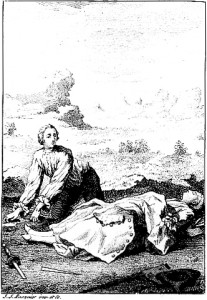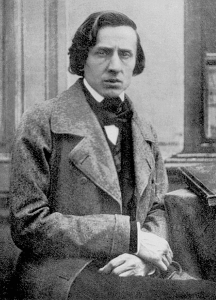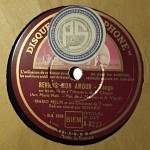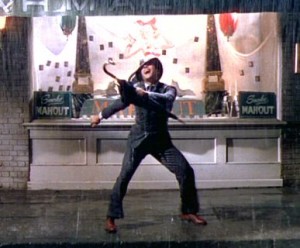While I was djing at a local milonga in Amsterdam a girl came to the DJ desk and told me: “I know this tango!” So I said: “Yes, it’s Melodía del corazón interpreted by Edgardo Donato and his orchestra.” She then explained that she didn’t really mean to know it from the milongas but from her sister’s piano lessons. Her sister was actually rehearsing on these tunes. On another session she told me that her sister was actually playing Fédéric Chopin’s Étude Op. 10 n°3 “Tristesse” in E major. And indeed the main theme of this piano étude directly entered into the tango Melodía del corazón. Not as a cheap carbon copy but nicely rearranged around the Chopin theme. Let’s say that the composers of this tango, Fioravante Di Cicco and Héctor María Artola, have been insprired by Frédéric Chopin (1810-1849).
- Edgardo Donato : Romeo Gavioli La melodía del corazón, 1940 (short extract):
“The great majority of Chopin’s compositions were written for the piano as solo instrument; all of his extant works feature the piano in one way or another. Chopin, according to Arthur Hedley, ‘had the rare gift of a very personal melody, expressive of heart-felt emotion, and his music is penetrated by a poetic feeling that has an almost universal appeal… Present-day evaluation places him among the immortals of music by reason of his insight into the secret places of the heart and because of his awareness of the magical new sonorities to be drawn from the piano.’ “ [Wikipedia]. So no wonder, they called this tango Melodía del corazón (The melody of the heart). This is also underlined with the lyrics by Carmelo Santiago sung by Romeo Gavioli in the 1940 Donato version.
The Edgardo Donato recording is not the only Di Cicco-Artola version, there is also a Francisco Canaro interpretation with the singer Francisco Amor. Both versions are from the year 1940, the SADAIC has the tango registered on the 19-01-1940.
At the root of all these versions there is an even earlier record with the same Chopin melody. This work is not based on the Di Cicco-Artola partition but on an arrangement by Mario Melfi in Paris and it’s called Reviens mon amour. The 78 RPM record contains an explicite note: “sur les motifs de Tristesse de F. Chopin”. This version is interpreted by Mario Melfi and his orchestra himself and the refrain singer is Benardi (Jean Bernardi?). The record has the HMV matrix number OLA 2958 (disk number K-8277) and has been issued in 1939 in France. Maybe it has freely inspired the Argentinian Di Cicco-Artola version. There are a lot of popular tangos which have been composed in Paris and then later performed in Buenos Aires. Let’s quote one of the most famous: Poema, for which Mario Melfi wrote the lyrics. Between the two wars, but also at other moments, Paris has been some kind of tango test tube where a lot of interesting ideas converged.
- Edgardo Donato : Romeo Gavioli La melodía del corazón, 1940 (short extract):
- Francisco Canaro : Francisco Amor La melodía del corazón, 1940 (short extract):
- Mario Melfi : Benardi Reviens mon amour, 1939 (short extract):
- Fédéric Chopin Étude Op. 10 n°3 “Tristesse” in E major by Tamás Vásáry (Piano):
The tango Vous, qu’avez-vous fait de mon amour ? is an interesting example, originally an Hungarian tango by the composer Tibor Barczi, it has been very popular in Paris during the 1930’s. There are serveral recordings of this tango in France, an often played and timeless version is certainly the one by Orlando et son orchestre du Bagdad from 1933 with the famous singer Tino Rossi. A couple of years later this tango came to Buenos Aires and has been recorded as Sueño Azul by Osvaldo Fresedo. Tibor Barczi’s original title of this tango is Jo a két szemedbe nézni.
- Osvaldo Fresedo : Roberto Ray Sueño Azul, 1937 (short extract):
- Miguel Orlando : Tino Rossi Vous, qu’avez-vous fait de mon amour ?, 1933 (short extract):
These are quite hidden cross references, only recognisable via the melody, but there are other tangos where the reference, for instance, to the classical music repertoire is openly anchored into the title like Danza Húngara No. 5 by Enrique Rodríguez. It is a tango foxtrot transcript of Johannes Brahms’ Hungarian Dances Nr. 5. Now the funny part about this is that Brahms isn’t the author: “Only numbers 11, 14 and 16 are entirely original compositions. The most famous Hungarian Dance is No. 5 in F♯ minor (G minor in the orchestral version), but even this dance was based on the csárdás by Béla Kéler titled Bártfai emlék which Brahms mistakenly thought was a traditional folksong.” [Wikipedia]
Now let’s have a look at the Gershwin question. Just a couple of days ago, as I was playing Sans souci (1944) with the Orchestra Miguel Caló, my friend H. told me that there is something of An American in Paris (1928) and a little bit of Rhapsody in blue (1931) in it. Especially Sans souci, composed by Enrique Delfino, is considered by some as the quintessence of Caló’s musical interpretation. Direct quotation of Gershwin or just brothers in style? The tango Sans souci has been created in Montevideo already back in 1917 by Enrique Delfino. If you compare the structure of the Caló and the Delfino version, you can hear that some connecting parts, repetitions, structures and especially something from the ending part of Caló’s Sans souci are not in the original scores. There is a passage in the ending part where he uses a blue note, a key you can find in Jazz and Blues music. You get minor where you expect major. Also Gershwin used blue notes quite frequently in his compositions. The following extract contains the blue note passage which reminds a little bit of Gershwin:
- Extract Miguel Caló : Instrumental Sans souci, 1944 Ending part 2:45 – 2:49, listen to the blue note:
- Miguel Caló : Instrumental Sans souci, 1944 (full version) There are some connecting parts, repetitions and structures which are not in the original Delfino version, like at 1:30 – 1:45 …:
- Enrique Delfino (Solo de piano) Sans souci, 1917 (full version) The original version:
- Gershwin plays Gershwin Rhapsody in Blue (Link to Youtube)

La mort de Manon Lescaut, illustration of Abbé Prévost’s Histoire du Chevalier Des Grieux et de Manon Lescaut
Enrique Delfino was a big admirer of Puccini, Verdi and Wagner and had a deep knowledge about musical theory. So if we are looking for musical quotations or references we can also cross listen to all these beautiful Enrique Delfino tangos and the work of Giacomo Puccini, Guiseppe Verde and Richard Wagner to find intersections in their universes. For instance the lyrics of his tango Griseta (1924) contain characters of Puccini’s opera La Boheme (Rodolfo, Mimì, Musetta, Schaunard), Manon Lescaut (Manon, Des Grieux) and Guiseppe Verdi’s La Traviata (adaptation of Marguerite Gautier, heroine of Alexandre Dumas, fils’ novel and play The Lady of the Camellias). It’s like a tribute to his favorite composers. And like in their plots, this beautiful tango can be seen as an allegory of the tuberculosis disease, a recurring motif in tango texts: See for the original lyrics here and for an English translation here.
- Carlos Di Sarli : Roberto Rufino Griseta, 1941:
(Di Sarli wiped the last stanza of the song text, the 1939 version by Biagi with Andrés Falgas contains only the middle stanza, not the first and neither the last stanza, the 1953 version by Francisco Canaro and Mario Alonso contains the complete lyrics)
But tango wasn’t exclusively inspired from classical or folk music, there have also been references to the popular music of the time. Especially in the late 1920’s and 1930’s there are a lot of foxtrots which are adaptations of world hits like the famous Singin’ in the rain by Nacio Herb Brown published in 1929 and Francisco Canaro’s reprise Cantando bajo la lluvia from 1929/1930. The text is translated to Spanish and the refrain singing is by Charlo, perfect voice for this repertoire. But just listen through all foxtrots by Canaro, Lomuto, Carabelli, Rodríguez and Fresedo and you will find a lot of known songs and tunes.
- Francisco Canaro : Charlo Cantando bajo la lluvia 1930:
I could go on and on with these references but I just want to conclude this little musical journey with the direct collaborations between tango and other musical genders, like you have seen in my article about Osvaldo Fresedo and Dizzy Gillespie, or the musical influences which changed the típica’s composition later in the 1940’s: Personally I believe that the Francisco Canaro orchestra remained still innovative during the 1940’s. To my ears it became very jazzy and I like especially the recordings with Carlos Roldán. Try to figure out which new instruments have been added to this típica! 😉
- Francisco Canaro : Carlos Roldán Cristal 1944




Hello,
Do you recognize this ?
Мой костер в тумане светит from Анна Литвиненко
You’ve written a marvelous article, Jens-Ingo with such heartfelt passion that’s brought such a pleasant smile to my face! I wholeheartedly applaud you in your efforts and hope you continue to bless us with your presence, your gifts and your service.
Your friend and colleague,
Julian
Bravo Jens-Ingo,
quelle belle surprise et quelle passion dans tes études.
C’est vraiment un plaisir pouvoir mieux comprendre la production et l’ispiration éuropéenne des orchestres de tango.
Un grand merci!
Great, Jens-Ingo!!
I am a great lover of classical music and it always surprise me when I hear an inspiration from it in any kind of music (and especially in tango-music).
I had a nice experience similar to yours recently – I´ve heard tango vals “Sobre las olas” for the first time and immediately I recalled the melody of the waltz I used to play as a child on a piano (in very simplified version). It was so great to hear that melody I used to know from my childhood! I thought it must have been composed by some of classical composers, so I found my old sheetnotes, but to my surprise, author was Juventino Rosas 🙂
and special thanks goes to you for finding that little piece of Gershwin´s Rhapsody in Blue in Caló song! 🙂
Hello Zuzana,
thank you very much 😉 By the way i didn’t really find a piece of Gershwin in the Caló tango but rather a passage which resembles Gershwin’s style. Or do you exactly know the passage as to be a 1:1 copy of Gershwin?
Greetings,
JI
Oh, yes, you are right, Jens-Ingo!
I´ve noticed that Gershwin inspiration in blue-note passage and without analysing in detail I directly considered it the same as Gershwin original.
But, listen to the Gershwin (that youtube version) from 8:59 – that is the part which is almost 1:1.
First 4 chords are the same, then G. continues with melody on the same tone, Calo continues with fourth higher while changing the chord.
p.s. listening to Sans souci again I found another inspiration, at 0:13 – 0:15 I would swear it sounds like Mozart 🙂 (some opera overture?)
and inspiration works both way. Have you noticed that motif from “Organito de la tarde” resembles little bit beginning of Beatles “Girl”?
and I noticed also this song by popular czech folk group resembles “Sosiego en la noche”….
http://www.youtube.com/watch?v=VFS_OUVIpTc
Zingo, I have just read your blogg entry. #like# I would like to get to a specific little detail on the Fédéric Chopin’s Étude Op. 10 n°3 “Tristesse” in E major aka. Melodia del corazon:
My personal impression: the Canaro version has a little let’s say “jazzy” foxtrott character with swing ambitions, as the more romantic (perceived) violines played donato version that shows a little more life of its own (further away from the original). Also noticeable from my point of view is the muffled trumpet (?) that takes over a part of the theme (00:35 to 1:04). I may be wrong. Pls. check, would you?
Do you by any chance happen to know if there’s a difference in the key in the Donato and Canaro version? Are they supposed to be in the same speed or is the difference intended?
Fantastic work Jens-Ingo, putting it all so nicely together!
Juliana, great you heard that in “La melodía del corazón”! Since I’ve analyzed keys and speed of tangos and found that most of what we dance to is off-key and has incorrect speeds your last question is for me:
This time, the versions I have of Donato and Canaro are almost at correct speed, so the tempo difference between Donato (67bpm) and Canaro (64bpm) is no technical error but intended.
Canaro plays in keys C major (Tristesse melody) and the corresponding A minor (Intro).
Donato starts in the same key (Am) but the singing is a minor third higher than the instrumental part:
Part 1a: Instrumental Intro in A minor; 0:35 modulation to C major
Part 1b: 0:37 Trisesse melody; 1:29-1:30 modulation to C minor
Part 2a: 1:30 Gavioli sings Intro in C minor; 2:04 modulation to Es major
Part 2b: 2:06 Gavioli sings Tristesse melody in Es major.
So, the instrumental parts of Donato and Canaro are in the same keys. Canaro’s singer Francisco Amor sings in the same keys, but Donato’s singer Romeo Gavioli sings a minor third higher.
For me the Donato version is closer to Chopin; Canaro seems such a happy fellow that even his tristesse comes with a wink. I love them both.
hello age,
one question: is this a new habit to change keys during the performance. did you key analyse the chopin version too, which is announced as to be E major? is there also key modulation happening or is it streight E major? generally major is associated to happy, pleasant, minor to sad, triste. was chopin also the happy guy. he looked more like to be depressed, didn’t he 😉
thank you,
JI
Thank you for your irrististable questions, Jens-Ingo. In tango, keys changes are quit common. Very often, this is to the corresponding major or minor key (every minor key has one corresponding major key; e.g. Am->C in “La melodía del corazón”) or only changing major/minor (e.g. D minor->D major in “Volver” and “A media luz”).
I think that, from a tango point of view, Chopin was only moderately depressed, but a modulation maniac: After Tristesse’s initial melody in E major, the 2nd part is B major and c# minor. Than, till the repetition of the initial melody the keys move wildly along: A major – A minor – C# diminished seven – F# major/minor nine – B major – B minor – D# half-diminished seven – G # major/minor nine – E# diminished seven – A# diminished seven – D# diminished seven – G# diminished seven – and B major (he, it is an Etude, a technical study piece).
Modulated enough? It ends with the initial melody in the initial key E major.
Donato and Canaro used from Chopin only the initial melody and played it lower, in C.
This piece shows that you can sound very sad in a major key, as you can sound happy in minor (e.g. “That’s the Way I Like It” by KC &the Sunshine Band and the Bee Gees’
You Should Be Dancin’
and me too!
Age
Grrrreat article, Jens-Ingo!
Imagine how more there is to discover it will sureley fill a book (at least!). Indeed the inspitations were shwashing in both directions. A further example of influences of European folk music is the Russian tune “Очи чёрные”- “Otschi tschornyje” (Black eyes), a melody commonly considered to be a gipsy song but based on “Hommage Valse Opus 21” of the German Florian Hermann (1884) with lyrics of Jewhen Hrebinkas (wikipedia). It’s still very popular: The interpretations are legend from traditional versions like from the Red Army Choir or Patricia Kaas (!) to contemporary jazz and even disco-salsa. However, it’s the blueprint of Francisco Canaro’s great Tango “Ojos negros que fascinan”.
If you like, listen to these:
http://www.youtube.com/watch?v=itbJkf74z24
You may like the version by Louis Armstrong:
http://www.youtube.com/watch?v=UnoCI2N9nWw
And of course Canaro with Roberto Maida (1935):
http://www.youtube.com/watch?v=2na5Ry8jRrU
When it comes to valse thre are even more “inspirations”. Most known the adaptations from the valses viennoise of Emile Waldteufel aka “Johann Strauss of Paris”: „Amor y primavera“ (F. Canaro, 1935), „Dolores“ (Los Provincianos, 1931), „Siempre fiel“ (E. Rodríguez, 1938) or „Tres jolie“. The latter not only recorded 1932 by OTV but by other European Orchestras like Marek Weber or in 1930, by Dajos Béla, famous leader of a “Salonorchester” and several jazz bands in Berlin. In 1935 he moved to Buenos Aires to play for Radio Splendid and after that for Radio El Mundo (wikipadia). So his fame must be well known in BsAs before, and quite possibel it was his recording which brought the Waldteufel to Tango.
One of my favourite theories of “reverse inspiration” is the couple “El Monito” – “In einer kleinen Konditorei”. The first, 1928, composed and recorded by Julio De Caro, the second composed by Fred Raymond (lyrics by Ernst Neubach) in 1929 – not an 1:1-adoption, but an Interpretation with an obvious similarity only in the refrain of the German smash hit. Accidentally? Somewhere – unfortunately I don’t know where – I read that Raymond was on a trip to America before; so belive it or not.
http://www.youtube.com/watch?v=K8h4EcghsHc
There is so much more to say. In the end it shows that the Tango Argentino was not a separated island but a interchanging member of the worldwide music community, crossing boarders of countries as well as of genres.
Stay tuned!
Henning
Hello Henning,
thank you for these additional examples and also the reverse inspirations. I haven’t really checked them out but I’m sure they are also strong in numbers 😉
Greetings,
JI
found another one 🙂
check the motif of Incertidumbre (from 0:40): http://www.youtube.com/watch?v=VddCRuHC5JE
it´s the Liszt Hungarian Rhapsody Nr.2: (from 7:30) http://www.youtube.com/watch?v=ntNUiTRig9k
Hi Zuzana, there is one exemple even more evident in the Donato version of El Chamuyo at 01.45: https://www.youtube.com/watch?v=TGoCjJBkwls. Enjoy! 🙂
@ Henning
Thanks for your examples.
Über den Titel Schwarze Augen / Black Eyes / Les yeux noirs / Otschi tschornyje könnte man seitenlang schreiben. Es soll ursprünglich eine russische Volksweise gewesen sein, wird aber auch gerne in der Zigeunertradition verortet. Es gibt viele wunderschöne Versionen in der ganzen Welt – manchen werden die Version von Pjotr Leschenko kennen. Im englischsprachigen Raum wurde es zu Black Eyes (z.B. die Version von Dorsey), in Deutschland wurde es zu Schwarze Augen (Rehmstedt, Widmann), in Frankreich zu Les Yeux noirs (Hot Club de France, Pierre Allier, beide Aufnahmen mit Django Reinhardt).
Hier eine sehr swingende Version, die mir sehr gut gefällt: http://www.youtube.com/watch?v=Y73O48g1am8
Von Canaro ist bekannt, dass er fast alle Arten von Musik aufnahm, die kommerziell erfolgreich waren. Zum Beispiel das in den dreissiger Jahren in ganz Europa bekannte Szomorú vasánap von Rezsö Seress, das in England zu Gloomy Sunday (Billie Holiday, Artie Shaw u.v.a.), in Deutschland zu Einsamer Sonntag, in Italien zu Triste Domenica wurde. Canaro spielte es als Triste Domingo 04/1937 ein. Es existiert auch eine Version mit Mercedes Simone (und unbekanntem Orchester) von 1937 (erschienen bei El Bandoneon EBCD 033).
Michael KI
Weitere Bezüge von Europa nach Argentinien:
Das schöne Isla de Capri wurde in Argentinien 1935 in der Version von Osvaldo Fresedo ein grosser Hit, ist aber eine Komposition von Will Grosz. Will Grosz war ein Wiener Komponist, Pianist und Orchesterleiter. Ab 1927 war er künstlerischer Leiter bei Grammophone Berlin. 1933 wurde er Leiter des Kammerspiel-Theaters in Wien. 1934 floh er vor den Nazis, für die Teile seiner Kompositionen (z.B. seine “Afrika-Songs”) entartete Musik waren, weiter nach England, dann nach den USA, wo er 1939 jung starb. Isla de Capri ist vermutlich seine bekannteste Komposition.
Der Musiker und Komponist Dajos Bela, der aus Deutschland vor den Nazis nach Argentinien fliehen musste, wurde bereits erwähnt.
Folgende Kompositionen von Dajos Bela in Argentinien sind namentlich erwähnt: Un beso de tus labios (vals), Adoro el mar (vals), Aquí estoy solo contigo (foxtrot), Okey Mr. Pepe (milonga), Noches de Hungría, Gitano. Jedoch gibt es von diesen Titeln meines Wissens keine Aufnahmen, die auf CD oder LP erschienen sind. Doch, es gibt eine Ausnahme: Bei der oben erwähnten Aufnahme »Noches de Hungria, Gitano« handelt es sich um den von Enrique Rodriguez 1942 aufgenommenen Foxtrot Noches de Hungria, erschienen auf der CD Bailando todos los ritmos.
(Zu Dajos Bela hatte ich eine ausführliche Biografie erstellt. Leider wurde auf der Webseite, wo ich meine Beiträge bisher eingestellt hatte, Zensur ausgeübt. Anstatt diesen “Änderungswünschen” nachzukommen, habe ich die Beiträge von dieser Seite entfernt. Meine kleine Bitte an die Leser: wenn sich jemand mit (einfacher) Webseitengestaltung auskennt und mir dabei helfen möchte, wäre ich für diese Hilfe sehr dankbar. Die andere Möglichkeit wäre, dass ich auf einer Tango-bezogenen Webseite meine Beiträge wieder einstellen könnte.)
Von Rodriguez gibt es noch einen anderen Titel aus Europa zu vermelden: Bombolo (erschienen auf der CD El “Chato” Flores 1937-39). Das Trio Lescano machte Bombolo zum grossen Hit in Italien, Rodriguez nahm es 1939 auf.
Es wäre sehr interessant, wenn noch weitere Bezüge zwischen Europa und Argentinien aufgeführt werden könnten.
liebe Grüsse
Michael KI